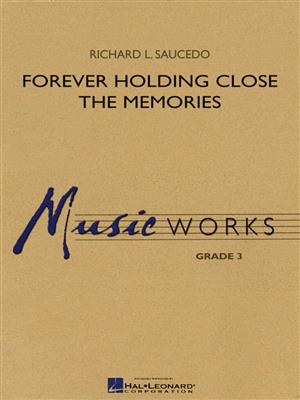Results
-
£45.95
Family Fugue - Timothy Loest
Inspired by Prokofiev's Peter and the Wolf, Family Fugue uses a narrator to blend the familiar folk song Frere Jacques with a delightful story line of the misadventures of three characters: Woodwind, Brass, and Percussion. An educational gem, this innovative work is ideal for teaching major and minor tonality, melodic retrograde, dynamic contrast, and of course, fugue form. Consider using a school administrator or local celebrity as your narrator. Easy to put together, great for recruiting, and forever memorable! (4:24)
Estimated dispatch 7-14 working days
-
 £189.99
£189.99Sir Eu - Thomas Doss
Sir Eu was commissioned by the regional music authority of Upper Austria and the brass band SoundINNBrass. The composition was meant to be very virtuoso and was written for the euphonium player Steven Mead, who premired it and has played it regularly worldwide. The title Sir Eu alludes to the master of the euphonium himself, and also to the concept of Europe. From jazz through romanticism to folkloristic elements - this work offers everything that the musical heart could wish for!
Estimated dispatch 7-14 working days
-
 £58.50
£58.50Highlander - Carl Strommen
This energetic concert or festival opener is sure to make your band sparkle! Highlander is full of bright melodies for the woodwinds and trumpets juxtaposed with bagpipe-like drones in the low brass, calling to mind images of old Scotland. Generous use of the piccolo adds to the Scottish flair. A lovely woodwind chorale provides for an interesting contrast in the middle section, only to be interrupted by the exciting main melody which modulates and brings Highlander to a fantastic finish. Highlander is another sparkling concert or contest showpiece by Carl Strommen!
Estimated dispatch 7-14 working days
-
 £66.95
£66.95Vistas - Steve Hodges
Featuring two melodic motives that are developed texturally and rhythmically throughout the piece, Vistas begins in a light, reflective manner before gradually building into a majestic contrapuntal statement by the brass. A driving percussion introduction begins the Vigoroso section and provides the rhythmic foundation for the second Vista. This minor setting of the initial motives provides an exciting variation that features a variety of meter changes and syncopated passages. A restatement of the initial motives with the driving rhythmic accompaniment begins an extended conclusion that brings the piece to a dynamic finish.
Estimated dispatch 7-14 working days
-
 £73.50
£73.50When Saint Nick Comes Marching In
New Orleans and its unique music history has impacted the entire world through the roots of jazz and popular music. Beginning with a trumpet solo inspired by Louis Armstrong, the piece quickly transitions to a Dixieland Jazz quintet. The full band, in the tradition of the New Orleans Brass Bands, joins the street parade with Saint Nick leading the celebration shouting "Heaux, Heaux, Heaux!" Staging and performance options abound. This will be the hit of your holiday concert!
Estimated dispatch 7-14 working days
-
£98.50
High Vibration - Green
A highly energetic concert opener, "High Vibration" is a bright and fast fanfare that will leave your audience in awe. This brilliantly scored fanfare will showcase the intensity of the brass section, the sweeping flourishes of the woodwind section, and the metallic nature of keyboard and auxiliary percussion. "High Vibration" emphasizes consistent transitioning from compound meter to simple meter exposing the ensemble to multiple time signatures and metric modulation.
Estimated dispatch 7-14 working days
-
£168.99
Concertino for Tuba - James Curnow
For Tuba in C (B.C.) Concertino for Tuba is a welcome addition to the somewhat limited library of works for solo tuba. James Curnow's great understanding of the low brass instruments and his dynamic, varied and colourful stylemake this a wonderful piece of music.
Estimated dispatch 7-14 working days
-
£79.50
Dies Irae - Elliot Del Borgo
This symphonic poem is based on a chant attributed to Jacopone da Todi (c. 1230 1306) and describes the day of wrath and impending doom, while asking for mercy and salvation. The opening, treated like a Gregorian chant, soon moves into a whirlwind of energy as a large battery of percussion adds to the bold statements in the brass and flourishes in the upper woodwinds. A substantial work for your next concert program.
Estimated dispatch 7-14 working days
-
£92.50
Urban Dances - Erik Morales
Drawing inspiration from elements of today's popular music, this serious concert piece focuses on rhythm as the primary developmental tool. Featuring a large battery of percussion, the piece uses the full gamut of colors available to the concert band. Heroic figures in the brass soar over the rhythmic pulses as the piece continues to build to a dynamic conclusion. Innovative and fresh! (4:10)
Estimated dispatch 7-14 working days
-
 £60.99
£60.99Forever Holding Close The Memories - Richard L. Saucedo
Composed as a celebration of life in memory of a beloved teacher, this tender and heartfelt tone poem is very melodic and tuneful in nature. It focuses on a series of soloistic woodwind lines interspersed with richly scoredemotional swells and sustained passages for the brass. Dur: 4:30
Estimated dispatch 7-14 working days
